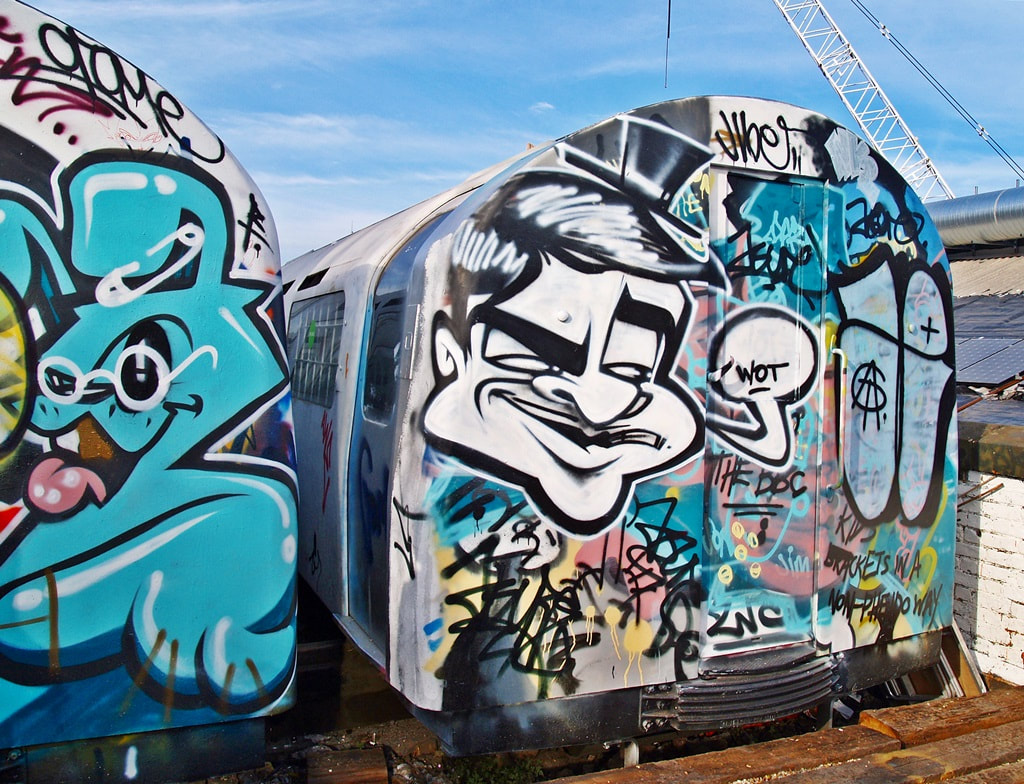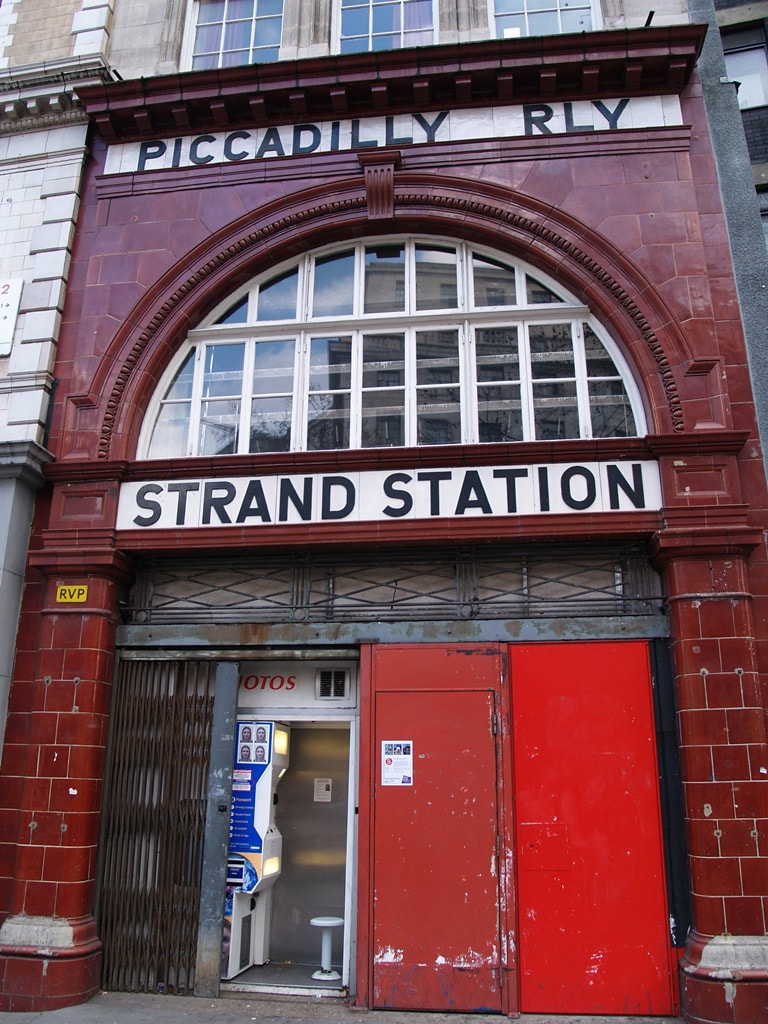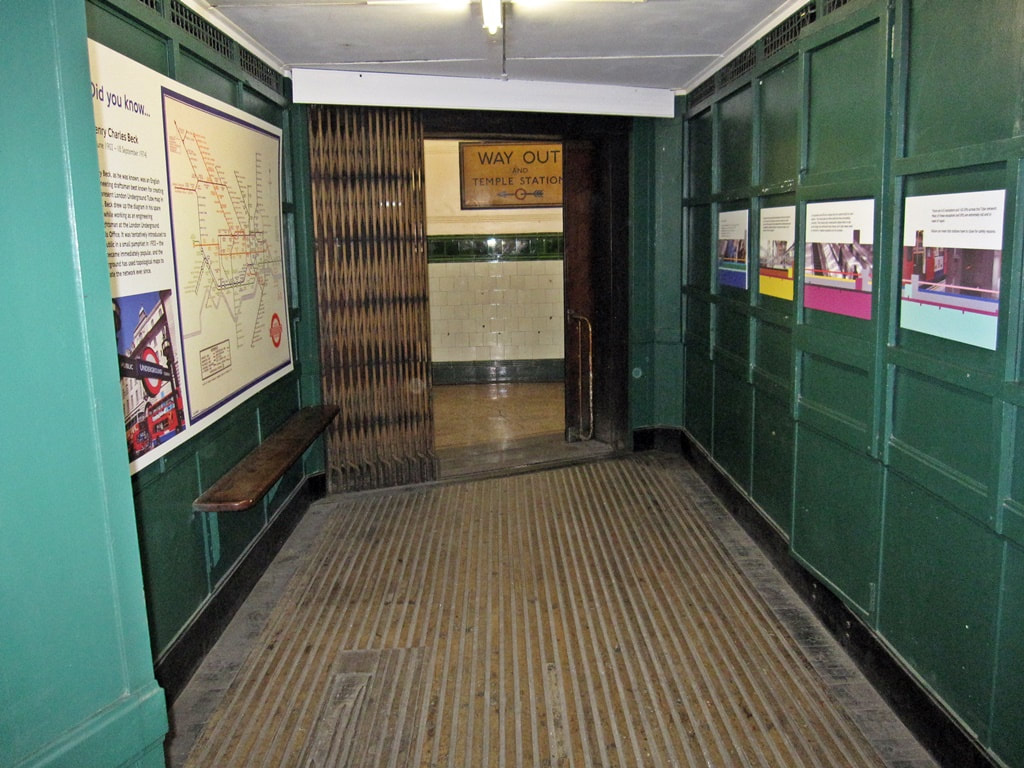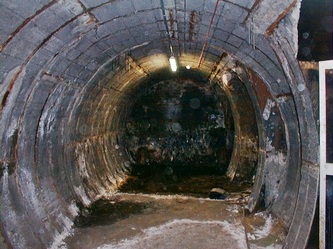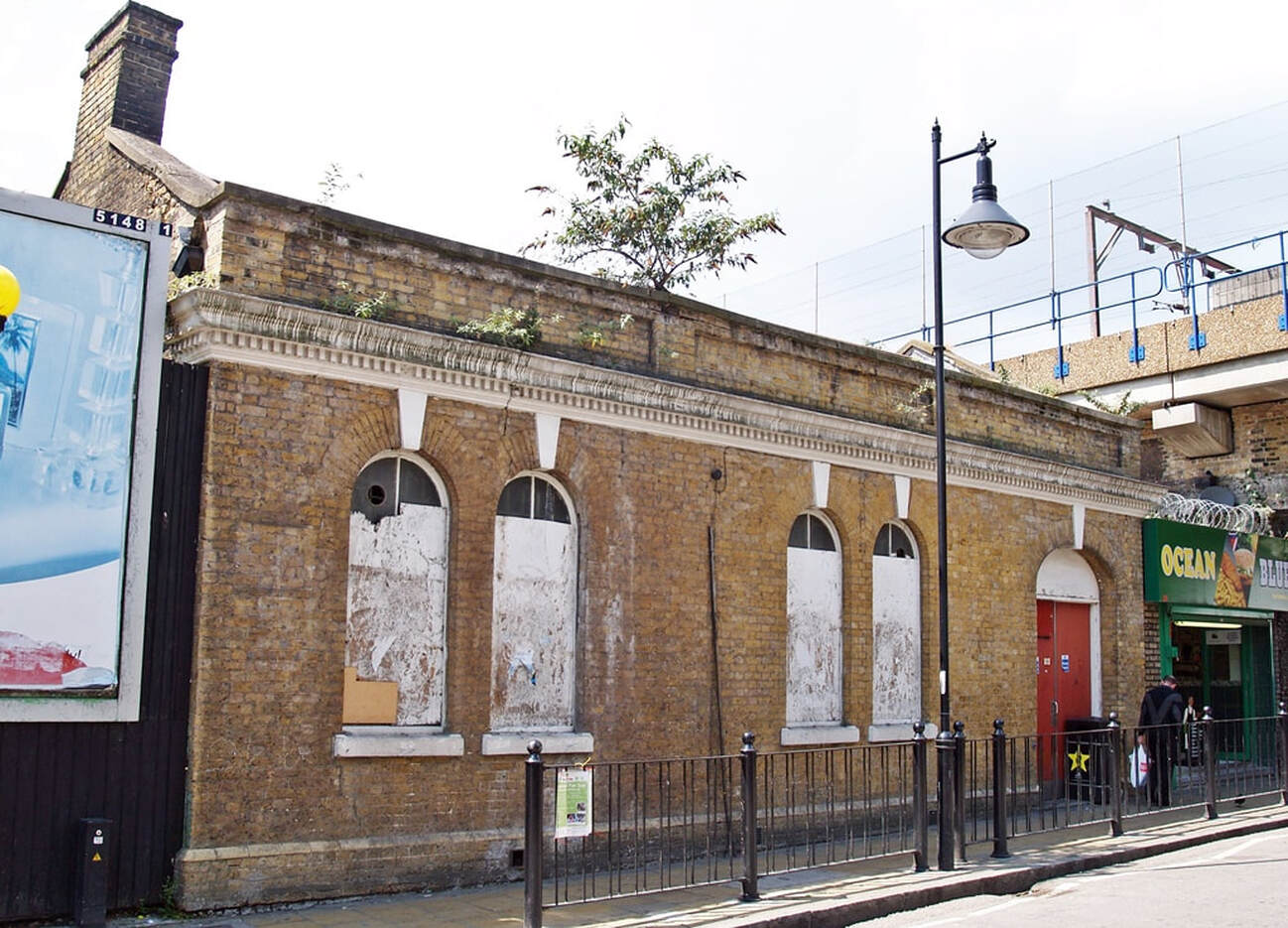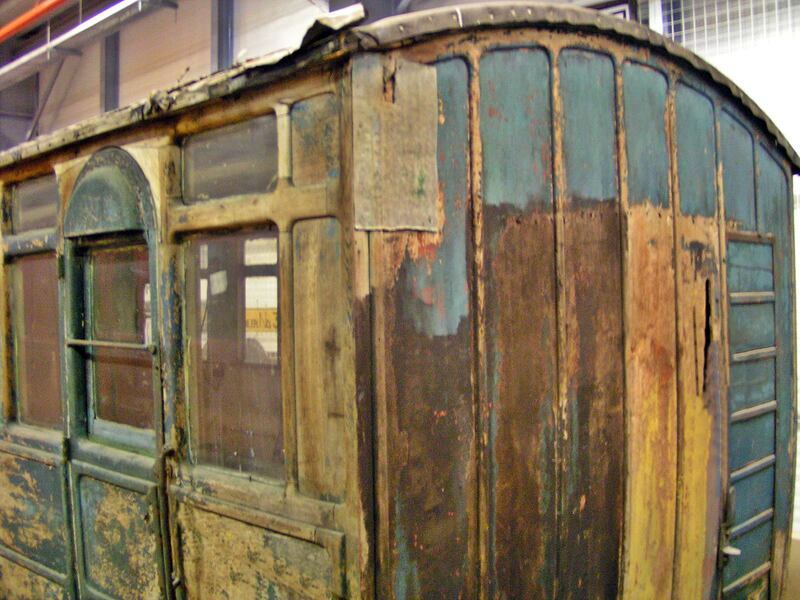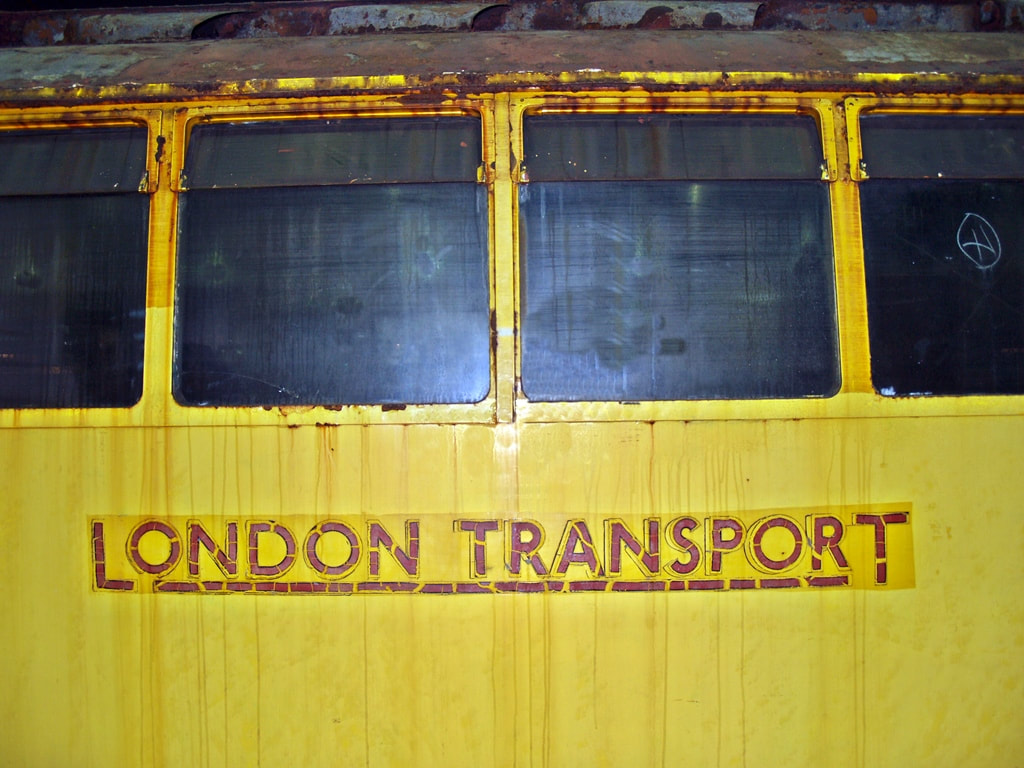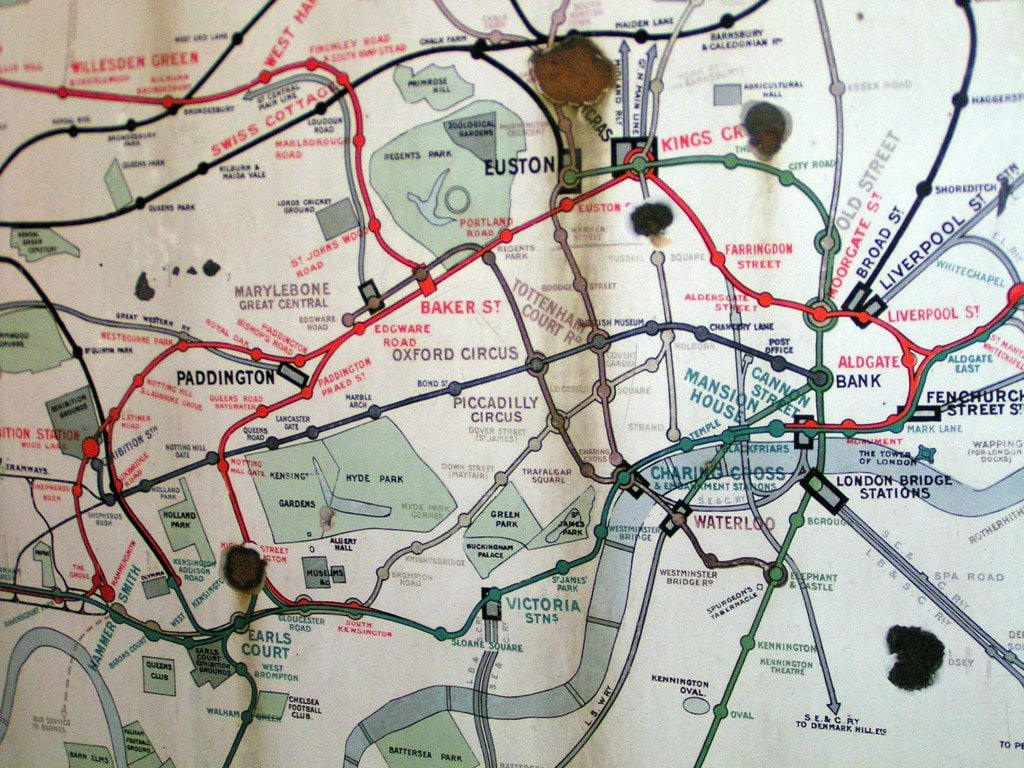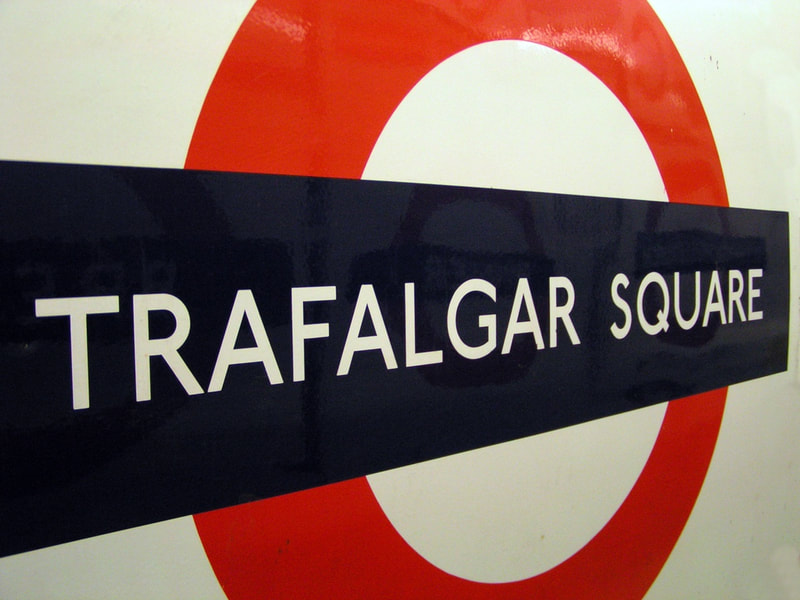London Transport - Tube Trains and Underground Stations
Join the mailing list (see bottom of page) to find out about Derelict London and London's Lost Rivers guided walks as soon as tickets are released plus news on my latest books and website updates. My latest book London's Lost Music Venues is out now and more information can be found at www.londonslostmusicvenues.com.
An anonymous fan of this site writes: "I’ve worked as a contracting engineer on both the over and underground railway networks for the many years and believe that you’d see the infrastructure and surrounding tundra as an Aladdin’s Cave of subject material. More frightening is the knowledge that a great deal of the jaw-dropping dilapidation is still operational. Access to the railways are, of course, restricted to authorised personal holding approved accreditations and even these are governed by levels of requirements for protection staff or the need for operational downtime. Nevertheless, the stations themselves and nearby public highways, footpaths and bridges are often great vantage points for gathering records of the appalling state of what’s costing the fare paying passenger occasionally a lot more than just too much money. Keep up the great work. Meanwhile, the creaking railway engineering industry battles on to fill the holes whilst main resources are focused on tarting up major stations and creating retail and commercial opportunities."
Shepherds Bush, W12 - Wood Lane Underground Station
This station opened in 1908 to coincide with the Franco-British exhibition and the Olympic Games in White City. The station was initially the western terminus of the Central line's precursor, the Central London Railway (CLR). By 1920 the line had been extended to Ealing Broadway. A distinctive feature of the White City exhibition was an elevated enclosed walkway (demolished many decades ago) incorporated into the station structure leading to exhibition halls.
As it proved impossible to modify Wood Lane station to take 8-car trains it closed in 1947 following the opening of the nearby White City station. The building survived until 2005 when it was demolished to make way for the new Westfield Shopping Centre development. The location of the former station is currently a bus interchange at the corner of Wood Lane and Ariel Way. Part of the old station facade has been dismantled has been preserved at London Transport's Depot museum at Acton Town.
In 2008, a new Wood Lane station was opened nearby on the Circle and Hammersmith & City lines.
This station opened in 1908 to coincide with the Franco-British exhibition and the Olympic Games in White City. The station was initially the western terminus of the Central line's precursor, the Central London Railway (CLR). By 1920 the line had been extended to Ealing Broadway. A distinctive feature of the White City exhibition was an elevated enclosed walkway (demolished many decades ago) incorporated into the station structure leading to exhibition halls.
As it proved impossible to modify Wood Lane station to take 8-car trains it closed in 1947 following the opening of the nearby White City station. The building survived until 2005 when it was demolished to make way for the new Westfield Shopping Centre development. The location of the former station is currently a bus interchange at the corner of Wood Lane and Ariel Way. Part of the old station facade has been dismantled has been preserved at London Transport's Depot museum at Acton Town.
In 2008, a new Wood Lane station was opened nearby on the Circle and Hammersmith & City lines.
South Kensington, SW7 - Rat on the District Line
This sad photograph of a dead rat shows what caused a shutdown of the District Line on London's Underground on the 5th October 2006. As you can see, the rat shorted out across the 630vDC connectors. The result was that the traction current switched off via the fail-safe devices and a line walk down the tunnels had to be instigated to find the cause of the dead short. They do not simply switch back on the current until they can be sure that it won't suddenly short out again. Thanks to Jon for the information and pic.
Aldgate E1 - Site of the former Aldgate East Underground Station
The original Aldgate East underground station, opened in 1884 on this Whitechapel High Street site just 500 feet west of the present day Aldgate East Station. In 1914, the street level building was rebuilt with a Lyons tea house incorporated on the ground floor. In 1938 the station was resited down the road as part of London Transport's 1935-1940 New Works Programme whereby the triangular junction of track at Aldgate was enlarged, to allow for a much gentler curve and for improved signalling and longer platforms to accommodate longer trains. Following closure after the last train had run in 1938 the new station opened the next morning. The old street level building survived here in a derelict condition until it was demolished in the 1950s and as you can see from these photographs, there were still some below street level remains to be seen behind the large advertising hoardings until 2019.
As of early 2021 the site is being redeveloped into an accommodation block for students. Apparently, the scheme will also deliver exhibition space for excavated remains of a 16th-century inn and theatre that once occupied the site and office space.
Pete Williams writes to this website: "the advertising hoarding at the old Aldgate station was only erected in 2012. The Olympic marathon passed the site, the hoarding erected to 'tart up' the site for the TV cameras".
As of early 2021 the site is being redeveloped into an accommodation block for students. Apparently, the scheme will also deliver exhibition space for excavated remains of a 16th-century inn and theatre that once occupied the site and office space.
Pete Williams writes to this website: "the advertising hoarding at the old Aldgate station was only erected in 2012. The Olympic marathon passed the site, the hoarding erected to 'tart up' the site for the TV cameras".
Inside Disused Jubilee Line Train
Note the old "Smoking" carriage sign and the Jubilee Line map when it used to terminate at Charing Cross.(The bars are those of on an adjacent carriage)
Old Ticket Machines
Who remembers these old ticket machines?
Ian Smith writes: "I remember these, I used to work on them as an apprentice at Lillie Bridge Depot, they used to come into the works in a filthy state and took age to clean. The ink took ages to get off your skin."
Ian Smith writes: "I remember these, I used to work on them as an apprentice at Lillie Bridge Depot, they used to come into the works in a filthy state and took age to clean. The ink took ages to get off your skin."
Strand, WC2 - Strand Tube Station (Later Renamed Aldwych)
Opened in 1907, Strand Tube Station was the terminus of a short branch off the Piccadilly Line (Aldwych Branch Line). It was then renamed the Aldwych to avoid confusion with the Northern Line’s Strand station. The original name can still be seen on the tiling.
During the Second World War, the branch was closed and the station used as a public air raid shelter, with the tunnels being employed to store the Elgin Marbles and other precious artefacts from the British Museum. Service resumed in 1946, but ended permanently in 1994 after the cost of a lift replacement was deemed uneconomic for the 600 or so passengers who passed through every day.
Because the station is at the end of the line, it has proved an ideal venue for film crews, and it can be glimpsed in films as diverse as Battle of Britain, Superman IV, The Krays, An American Werewolf in London and Patriot Games. It has also represented ‘Sun Hill’ tube station in television’s The Bill and appeared in Take It or Leave It (the film that chronicles the career of pop group Madness). The tunnel was used in Prodigy’s ‘Firestarter’ pop video. Legend has it that people who are employed to clean the stations and tunnels are scared of a mysterious figure, who roams the station at night. Legend is that the ghost that haunts the station is that of an actress, who did not manage to fulfil her dreams - the station stood on the former plot of the Strand Theatre.
During the Second World War, the branch was closed and the station used as a public air raid shelter, with the tunnels being employed to store the Elgin Marbles and other precious artefacts from the British Museum. Service resumed in 1946, but ended permanently in 1994 after the cost of a lift replacement was deemed uneconomic for the 600 or so passengers who passed through every day.
Because the station is at the end of the line, it has proved an ideal venue for film crews, and it can be glimpsed in films as diverse as Battle of Britain, Superman IV, The Krays, An American Werewolf in London and Patriot Games. It has also represented ‘Sun Hill’ tube station in television’s The Bill and appeared in Take It or Leave It (the film that chronicles the career of pop group Madness). The tunnel was used in Prodigy’s ‘Firestarter’ pop video. Legend has it that people who are employed to clean the stations and tunnels are scared of a mysterious figure, who roams the station at night. Legend is that the ghost that haunts the station is that of an actress, who did not manage to fulfil her dreams - the station stood on the former plot of the Strand Theatre.
The pics of Aldwych tube station below were taken by Brian Mcdonnell:
Metropolitan Railway Trailer Coach
This trailer car built in 1904 is the only survivor from the first batch of electric tube trains. It was acquired from the army in Shoeburyness and transferred to the Woolwich Museum (now defunct) where it was set ablaze by vandals. The car is now kept at the TFL depot in Acton.
Waterloo and City Line Train
The Waterloo & City line - known as "the drain" to its users - is a short underground railway line with only two stations, Waterloo and Bank. It exists almost exclusively to serve commuters between Waterloo mainline station and the City of London.
The train below is rolling stock from 1940 which replaced wooden carriages. The 1940 stock was eventually replaced in 1992 & taken out of Waterloo station via cranes and transported on the back of lorries to Glasgow to be scrapped. This one survived intact.
The train below is rolling stock from 1940 which replaced wooden carriages. The 1940 stock was eventually replaced in 1992 & taken out of Waterloo station via cranes and transported on the back of lorries to Glasgow to be scrapped. This one survived intact.
Islington, EC1 - City Road Tube Station
City Road (located on the line between Old Street and Angel) was one of the stations built when the City & South London Railway (now part of the Northern line) opened its extension from Moorgate to Angel in 1901.
City Road Station was little used, and discussions of its closure took place as early as 1908. In 1916 one of the few customers was killed when a guard signalled for a train to depart before all the passengers had alighted. The station remained open until 1922 and the platforms were removed though the short station tunnels just remain visible from trains passing through. During World War II, the station was converted for use as an air-raid shelter.
The station building remained until the 1960s, when all but the structure immediately around the original lift shaft (that had been converted for use as a ventilation shaft) was demolished. The lift shaft (pictured here) was demolished in 2016 and today there is nothing left at street level to indicate the site of the former station. The Bunhill 2 Energy Centre opened on the site in 2020, capturing waste heat from the Northern Line tunnels to provide heat to nearby buildings.
City Road Station was little used, and discussions of its closure took place as early as 1908. In 1916 one of the few customers was killed when a guard signalled for a train to depart before all the passengers had alighted. The station remained open until 1922 and the platforms were removed though the short station tunnels just remain visible from trains passing through. During World War II, the station was converted for use as an air-raid shelter.
The station building remained until the 1960s, when all but the structure immediately around the original lift shaft (that had been converted for use as a ventilation shaft) was demolished. The lift shaft (pictured here) was demolished in 2016 and today there is nothing left at street level to indicate the site of the former station. The Bunhill 2 Energy Centre opened on the site in 2020, capturing waste heat from the Northern Line tunnels to provide heat to nearby buildings.
Mayfair, W1 - Down Street Tube Station
Down Street was opened on what is now the Piccadilly Line in 1907, and it closed in 1932. It was never very busy. The well-heeled local residents tended not to use the tube, and the area was, in any case, already served by other nearby underground stations.
By 1939 both platforms had largely been bricked up, a concrete cap had been fitted over the shaft, and filters and steel doors had been installed to prevent any gas contamination. The station was therefore an obvious place for Winston Churchill and his wartime Cabinet to use as a deep-level shelter until the Cabinet War Rooms in Whitehall were completed. It then served as the wartime headquarters of the Railway Executive Committee.
By 1939 both platforms had largely been bricked up, a concrete cap had been fitted over the shaft, and filters and steel doors had been installed to prevent any gas contamination. The station was therefore an obvious place for Winston Churchill and his wartime Cabinet to use as a deep-level shelter until the Cabinet War Rooms in Whitehall were completed. It then served as the wartime headquarters of the Railway Executive Committee.
Join the mailing list (see bottom of page) to find out about Derelict London and London's Lost Rivers guided walks as soon as tickets are released plus news on my latest books and website updates. My latest book London's Lost Music Venues is out now and more information can be found at www.londonslostmusicvenues.com.
Euston, NW1 - Euston Tube Station (Old Entrance)
This station opened in 1907, served the Charing Cross, Euston and Hampstead Railway(CCE&HR) one of the two original underground lines serving Euston mainline station. The second of the lines was the City and South London Railway. Each line, who were competitors, had their own station but had an interconnecting passenger tunnel with an additional shared entrance inside the mainline station which is what most passengers used.
After both underground lines were combined to what we now know as the Northern line the two separate station buildings were closed in 1914. One was demolished and this one survives as a ventilation shaft although thanks to HS2 this building is due to be demolished too.
After both underground lines were combined to what we now know as the Northern line the two separate station buildings were closed in 1914. One was demolished and this one survives as a ventilation shaft although thanks to HS2 this building is due to be demolished too.
Brompton, SW3 - Brompton Road Tube Station
Brompton Road tube station is a disused station on the Piccadilly Line. It is located between Knightsbridge and South Kensington and opened in 1906. It was convenient for both the Brompton Oratory and the Victoria and Albert Museum, but the station still saw little traffic and within 3 years some services passed through it without stopping. Nearby Knightsbridge station was modernised in 1934 with escalators replacing lifts & provided with a new entrance built closer to Brompton Road station, Brompton Road station itself closed.
During the war, the old station was the Royal Artillery's Anti-Aircraft Operations Room for central London.
The entrance and exits to the lifts were on Brompton Road but was demolished in 1972. The Cottage Place side of the building originally used for staff access still survives albeit partly incorporated into a larger building. The Old London Underground Company proposed turning the above-ground buildings into a restaurant and make the underground space available to the London Fire Brigade Museum though that never happened and in 2014 the site was sold for £53 million to a billionaire Ukrainian businessman who claims an intention to convert it to residential use.
During the war, the old station was the Royal Artillery's Anti-Aircraft Operations Room for central London.
The entrance and exits to the lifts were on Brompton Road but was demolished in 1972. The Cottage Place side of the building originally used for staff access still survives albeit partly incorporated into a larger building. The Old London Underground Company proposed turning the above-ground buildings into a restaurant and make the underground space available to the London Fire Brigade Museum though that never happened and in 2014 the site was sold for £53 million to a billionaire Ukrainian businessman who claims an intention to convert it to residential use.
St Johns Wood, NW8 - Marlborough Road Tube Station
This station opened in 1868 on the Metropolitan & St. John's Wood Railway (now the Metropolitan Line). It had been a little-used station apart from some peak days during cricket season due to its proximity to Lord's Cricket Ground.
In the 1930s the Metropolitan line was suffering congestion where trains from its many branches shared the limited capacity on this stretch between Finchley Road and Baker Street. To ease this congestion, new tunnels were constructed and the Metropolitan's services branch Stanmore were transferred to the Bakerloo line (they are now on the Jubilee line) and ran to Baker Street through the new tunnels. Upon the transfer in 1939, Marlborough Road station was closed and replaced by St. John's Wood station.
The remains of the platforms and an outside shot of the station building and booking hall (then an Aberdeen Angus Steak House) were included in a scene from Metro-land, a 1973 BBC documentary presented by Sir John Betjeman. The building survives today and up to a few years ago was in use as a Chinese restaurant. These days it serves as an electrical sub-station. The street that Marlborough Road station was named after has been renamed Marlborough Place.
In the 1930s the Metropolitan line was suffering congestion where trains from its many branches shared the limited capacity on this stretch between Finchley Road and Baker Street. To ease this congestion, new tunnels were constructed and the Metropolitan's services branch Stanmore were transferred to the Bakerloo line (they are now on the Jubilee line) and ran to Baker Street through the new tunnels. Upon the transfer in 1939, Marlborough Road station was closed and replaced by St. John's Wood station.
The remains of the platforms and an outside shot of the station building and booking hall (then an Aberdeen Angus Steak House) were included in a scene from Metro-land, a 1973 BBC documentary presented by Sir John Betjeman. The building survives today and up to a few years ago was in use as a Chinese restaurant. These days it serves as an electrical sub-station. The street that Marlborough Road station was named after has been renamed Marlborough Place.
Knightsbridge, SW1 - Hyde Park Corner Tube Station
The building that opened in 1906 was the original entrance/exit for Hyde Park Corner underground only to close when escalators replaced the lifts and a new entrance opened across the road in 1932 making Hyde Park Corner station one of the few stations which have no associated buildings above ground, the station being fully underground.
The former station was opened as a restaurant and music venue in 1982 by Peter Boizot, Pizza Express’s founder, George Melly, Mica Paris, John Dankworth and Cleo Laine, and a long list of others on the international jazz circuit played here. Dankworth went straight there for a party straight after getting his knighthood at Buckingham Palace. After nearly 30 years of pizza and jazz, this venue finally closed down in 2010 and has been converted into The Wellesley a "boutique hotel" when opened was described as London's first six-star hotel.
The former station was opened as a restaurant and music venue in 1982 by Peter Boizot, Pizza Express’s founder, George Melly, Mica Paris, John Dankworth and Cleo Laine, and a long list of others on the international jazz circuit played here. Dankworth went straight there for a party straight after getting his knighthood at Buckingham Palace. After nearly 30 years of pizza and jazz, this venue finally closed down in 2010 and has been converted into The Wellesley a "boutique hotel" when opened was described as London's first six-star hotel.
Just Off Brick Lane, E1 - Shoreditch Tube Station
This station opened in 1876 as a railway station later becoming part of the tube network as the terminus on the East London Line before the station closed in 2006 and the whole tube line a year later. Shoreditch was one of the least-used tube stations on the network, with just over 1000 passengers per day as it only opened at rush hours during weekdays and a few hours on a Sunday to serve Brick Lane Market which was nowhere near as fashionable as it is these days. All the stations along the East London Line were reused by the London Overground in 2010 apart from Shoreditch which was replaced by the newly built Shoreditch High Street station nearby.
The station is featured in the short story 'My Father the Liar' directed by Bob Hoskins and starring Ray Winstone as part of 1999's 'Tube Tales', a collection of nine short films.
The building was used as a pop up cinema in 2014 and one of the recent plans is to demolish the building and replace it with a 7-storey block of flats with the station's brickwork incorporated into the top floor of the new building. Meanwhile, the building is a magnet for graffiti artists and the artwork tends to change on a weekly basis. The pictures below were taken shortly after the closure of the station, so you can see the building underneath all the paint.
The station is featured in the short story 'My Father the Liar' directed by Bob Hoskins and starring Ray Winstone as part of 1999's 'Tube Tales', a collection of nine short films.
The building was used as a pop up cinema in 2014 and one of the recent plans is to demolish the building and replace it with a 7-storey block of flats with the station's brickwork incorporated into the top floor of the new building. Meanwhile, the building is a magnet for graffiti artists and the artwork tends to change on a weekly basis. The pictures below were taken shortly after the closure of the station, so you can see the building underneath all the paint.
Kentish Town NW1 - South Kentish Town Tube Station
Situated on the Northern Line between Camden Town and Kentish Town this station opened in 1907. It was closed during a power station strike in 1924 and never reopened. The main part of the building is now used as a Cash Converters and part of the underground area is used by an escape room game company.
A passenger accidentally alighted from a train which stopped at a red light at South Kentish Town soon after closure and although he soon realised his mistake and got back on the train, this inspired a published short story which told of a Mr. Brackett, who was trapped in the dark, deserted station for four days having stepped off a train stopped by a red signal. This story was expanded further by Sir John Betjeman on a BBC broadcast called "South Kentish Town" that he made in the 1950s.
A passenger accidentally alighted from a train which stopped at a red light at South Kentish Town soon after closure and although he soon realised his mistake and got back on the train, this inspired a published short story which told of a Mr. Brackett, who was trapped in the dark, deserted station for four days having stepped off a train stopped by a red signal. This story was expanded further by Sir John Betjeman on a BBC broadcast called "South Kentish Town" that he made in the 1950s.
Barnsbury N1 - York Road Tube Station
This Underground station, a short distance from King's Cross Station, opened on what is now the Piccadilly Line in 1906. Awkwardly situated in a run-down industrial area, the station never received many visitors. From 1909, some trains didn’t stop at the station during the week, and by 1918 there was no Sunday service. It closed completely in 1932.
The station was designed by Leslie Green, the architect responsible for dozens of stops on the Bakerloo, Piccadilly and Northern lines. He was famous for using ox-blood red tiles and elegant, Arts & Crafts lettering. The raised writing on York Road’s facade was chiselled off in the 1930s, so that the new owners had a flat surface on which to mount their signs; these were removed in 1989, and the distinctive white-tile signage has been visible ever since.
With the recent redevelopment of the King's Cross neighbourhood vicinity there have been proposals to reopen the station.
The station was designed by Leslie Green, the architect responsible for dozens of stops on the Bakerloo, Piccadilly and Northern lines. He was famous for using ox-blood red tiles and elegant, Arts & Crafts lettering. The raised writing on York Road’s facade was chiselled off in the 1930s, so that the new owners had a flat surface on which to mount their signs; these were removed in 1989, and the distinctive white-tile signage has been visible ever since.
With the recent redevelopment of the King's Cross neighbourhood vicinity there have been proposals to reopen the station.
Shadwell, E1 - Old Tube Station Building
This station building was one of the oldest on the underground network until it closed in 1983. It was first opened by the East London Railway in 1876 and later becoming part of the tube network on the East London Line.
A new ticket hall was built almost next door in 1983, replacing this original building which lay derelict for many years until it was eventually demolished in 2010. The new ticket hall continued to serve the London Underground until the East London Line closed and reopened in 2010 on the London Overground network. The site of the old building now accommodates a bike hire stand.
A new ticket hall was built almost next door in 1983, replacing this original building which lay derelict for many years until it was eventually demolished in 2010. The new ticket hall continued to serve the London Underground until the East London Line closed and reopened in 2010 on the London Overground network. The site of the old building now accommodates a bike hire stand.
Shoreditch, EC2 - Village Underground
These converted Jubilee line carriages sitting on the top of an old railway viaduct in the middle of Shoreditch are quite a local landmark. The carriages that were positioned here in 2006 are currently used as co-working spaces. Next to the viaduct was an old Victorian warehouse which had been a coal store for the railway. Village Underground put a roof on it and have transformed it into a live music and club venue.
Finally, here are a few photographs of old carriages, signs, etc spotted at the London Transport Museum Depot at Acton
Link to other pages on this website:
Derelict London Transport - Railway Stations, Lines and Rolling Stock
Derelict London Transport - Trams
Paul Talling's Derelict London - all photographs are copyright © 2003-2024
Click the envelope icon to join the mailing list for occasional news on website updates, new book releases and Paul's guided walking tours. Follow Derelict London on Facebook and Twitter
Please do not contact me with property/ filming/photo shoot location queries
Click the envelope icon to join the mailing list for occasional news on website updates, new book releases and Paul's guided walking tours. Follow Derelict London on Facebook and Twitter
Please do not contact me with property/ filming/photo shoot location queries


